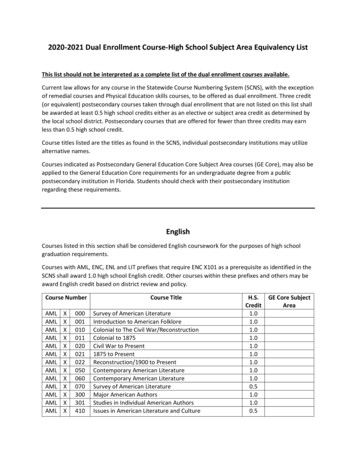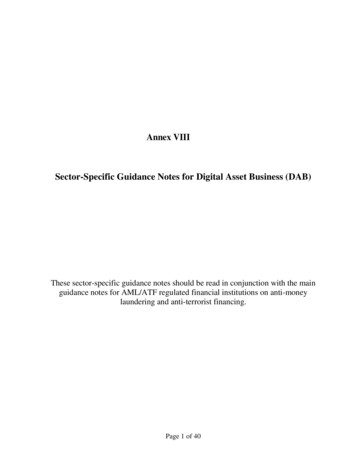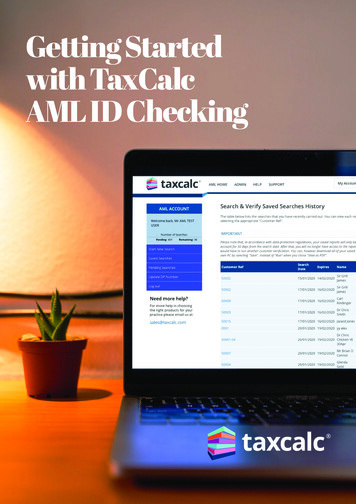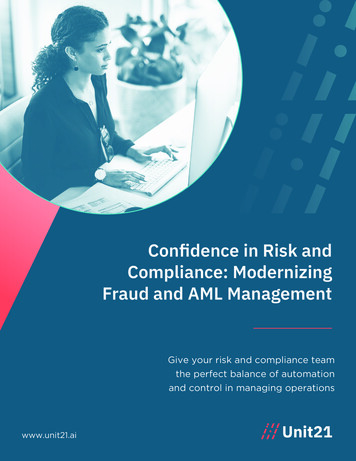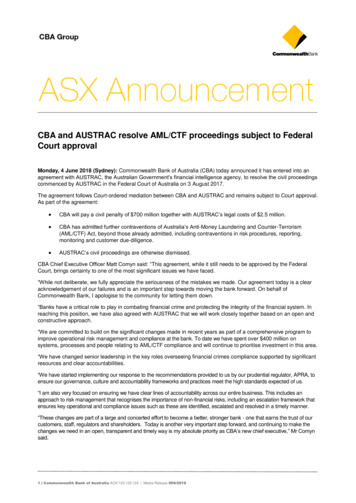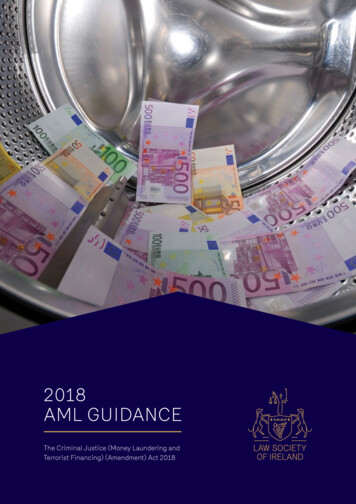
Transcription
2018AML GUIDANCEThe Criminal Justice (Money Laundering andTerrorist Financing) (Amendment) Act 2018
2018 AML Guidance - The Criminal Justice (Money Laundering and Terrorist Financing) (Amendment) Act 2018 - Version 1INDEXSECTIONTITLEPAGE1 INTRODUCTIONATHE 2018 ACT IS NOT A SEA-CHANGE 1BCHANGES TO CURRENT GUIDANCE 1CCHANGES TO STATUTORY OBLIGATIONS 2DSUMMARY OF HEADLINE IMPACTS OF THE 2018 ACT ON SOLICITOR AML DUTIESEGLOSSARY 4FHOW TO TRANSITION TO FULL COMPLIANCE WITH THE 2018 ACT 6GSCOPE AND STATUS OF GUIDANCE 822 BUSINESS RISK ASSESSMENTSABACKGROUND 9 Are Business Risk Assessments a new concept? What is the reason for the change?BTHE STATUTORY REQUIREMENT TO CONDUCT BUSINESS RISK ASSESSMENTS9 What does section 30A require?CCURRENT GUIDANCE ABOUT ASSESSING ML/TF RISK 10 What is the Law Society’s current best practice guidance for assessing the ML/TFrisk exposure of a solicitors’ firm?DTHE SOCIETY’S EXPECTATIONS IN RELATION TO BUSINESS RISKASSESSMENTS WHEN THEY MONITOR/SUPERVISE A FIRM’S AML COMPLIANCE11ESTEP-BY-STEP GUIDANCE ABOUT HOW TO CONDUCT A BUSINESSRISK ASSESSMENT? 11STEP 1 - Develop your knowledge of ML/TF risks inherent in legal services 12i.The known legal services vulnerable to money launderingii.Legal Sector Vulnerabilities set out in Ireland’s National Risk Assessmentiii.The Internationally Recognised Money Laundering Typologies in Legal Sectoriv.The Internationally Recognised ML/TF Red Flag Indicators in the Legal Sectorv.Comparative ML/TF vulnerabilities observed by the SRA in England and Wales.vi.Comparative Guidance for the legal sector in England and Wales, published bythe Legal Sector Affinity Group and approved by HM TreasurySTEP 2 - Draft your firm’s Business Risk Assessment 17 Customer type Products and services provided by the solicitors’ firm Countries/geographical areas Transaction type Delivery channel typeSTEP 3 - Consider adapting the Society’s Business Risk Assessment Template 18STEP 4 - Obtain Senior Management Approval of the firm’s Business Risk Assessment18STEP 5 - Keep Business Risk Assessments under review in line with Policies,Controls and Procedures 18
2018 AML Guidance - The Criminal Justice (Money Laundering and Terrorist Financing) (Amendment) Act 2018 - Version 1INDEXSECTIONTITLEPAGE3 POLICIES, CONTROLS AND PROCEDURESABACKGROUND 19 Are Policies, Controls and Procedures a new concept?BTHE STATUTORY REQUIREMENT 19 What’s new? What does the new section 54 require?CINFORMATION ABOUT HOW TO PREPARE PCPS 21 What should PCPs include/cover? Who is responsible for developing and monitoring/keeping PCPs up-to-date? What is the Society’s recommended approach to bring your current AML policiesDup-to-date with new PCP requirements?WHAT AREAS SHOULD PCPS COVER? 231.ML/TF risk management practices2.CDD controls3.Reliance and record keeping4.How ML/TF suspicions are managed5.Review, monitoring and management of compliance with the PCPsEWHO DO PCPS APPLY TO IN A FIRM? 27FWHAT ARE THE ADDITIONAL PCP MEASURES WHICH THE LAW SOCIETY CANDIRECT A SOLICITORS’ FIRM TO TAKE? 28GINFORMATION ABOUT THE NEW REQUIREMENT TO HAVE SYSTEMS IN PLACETO RESPOND TO ENQUIRIES FROM AN GARDA SIOCHANA 294 CUSTOMER RISK ASSESSMENTSABACKGROUND 30 Are Customer Risk Assessments a new concept? What is the purpose of the change? Existing guidance about how to assess customer/legal service ML/TF RiskBTHE STATUTORY REQUIREMENT 31 What’s new? What does the new section 30B require? What does section 30B mean in practice for solicitors?CINFORMATION ABOUT HOW TO COMPLETE CUSTOMER RISK ASSESSMENTS 34 What is the society’s guidance for solicitors when complying with 30B requirements? Consider adapting the Society’s Sample Customer Risk Assessment FormsDWHAT ARE THE SOCIETY’S EXPECTATIONS IN RELATION TO THE NEW STATUTORYCUSTOMER RISK ASSESSMENT REQUIREMENTS? 355 UPDATED CHAPTER 5 CUSTOMER DUE DILIGENCE GUIDANCEASUMMARY 371.Standard CDD (sections 33 – 35)2.Simplified (section 34A)3.Enhanced (sections 37 and 39)
2018 AML Guidance - The Criminal Justice (Money Laundering and Terrorist Financing) (Amendment) Act 2018 - Version 1INDEXSECTION5TITLEPAGEBSTANDARD CDD 38Generally, how should CDD be applied?Standard CDD Measure 1 - Identifying the client and verifying the client’s identity Identification or verification? What does identification mean? What does verification mean and what sources of evidence can be used? When must identification and verification be undertaken? What are the requirements where contact is non face-to-face? What is electronic verification? What about using electronic verification providers? How can the identity of different types of clients be verified? New requirement to identify persons acting on behalf of the client introduced38by the 2018 Act?Standard CDD Measure 2 - Identifying the beneficial owners and taking measuresreasonably warranted by the ML/TF risk to verify their identity 43What is the obligation to identify beneficial owners? What are the different definitions of “beneficial owner”?Standard CDD Measure 3 - Obtaining information reasonably warranted by the riskof ML/TF on the purpose and intended nature of the business relationship 47 Do I need to obtain evidence or “determine” the source of funds/wealth?Standard CDD Measure 4 - Conducting ongoing monitoring 50How can ongoing monitoring of the business relationship be conducted?CSIMPLIFED CDD 51What is the statutory criteria for SCDD eligibility?D What does section 34A mean in practice for solicitors?ENHANCED CDDEnhanced CDD Duty 1 - Complex/Unusual transactions - Section 36A 53Enhanced CDD Duty 2 - Risk that client involved in ML/TF, ascertain PEP status- Section 37 53Who is a PEP? What do I have to do if my client is a PEP? Establishing source of wealth and funds How can PEPs be identified?Enhanced CDD Duty 3 - Client is established or resides in a high-risk third country- Section 38A 58 Who is on the list? Can a country pose a higher ML/TF Risk but not be designated as a“high-risk third country”? Other useful resourcesEnhanced CDD Duty 4 - Business relationship (client or AML-regulated legal service)is high risk for ML/TF - Section 39 59 High risk circumstances requiring enhanced CDD where non face-to-face clients
2018 AML Guidance - The Criminal Justice (Money Laundering and Terrorist Financing) (Amendment) Act 2018 - Version 1SECTION 1 - INTRODUCTIONCONTENTSA.A.THE 2018 ACT IS NOT A SEA-CHANGEB.CHANGES TO CURRENT GUIDANCEC.CHANGES TO STATUTORY OBLIGATIONSD.SUMMARY OF HEADLINE IMPACTS OF THE 2018 ACT ON SOLICITOR AML DUTIESE.GLOSSARYF.HOW TO TRANSITION TO FULL COMPLIANCE WITH THE 2018 ACTG.SCOPE AND STATUS OF GUIDANCETHE 2018 ACT IS NOT A SEA-CHANGE2.1.1. This is guidance for solicitors about the Criminal Justice (Money Laundering and TerroristFinancing) Act 2018 (the ‘2018 Act’) which completed all stages in the Oireachtas on 7 November2018. The Society understands that the Act will be commenced in the shortest possible timefollowing enactment and by the end of November 2018. This guidance supplements the Society’scurrent Guidance Notes for Solicitors on Anti-Money Laundering (AML) Obligations (the ‘2010Guidance’) as well as the Summary Sheet for the Criminal Justice (Money Laundering and TerroristFinancing) Act 2013. In order to provide the most up-to-date guidance to best meet the needs ofmembers, this Guidance will be a ‘living document’ which may be updated as needed to draw uponevolving guidance for other designated bodies in Ireland as well as best practice for lawyers inother jurisdictions.2.1.2. The Fourth Directive requires Member States to further embed the risk-based approach to prevent itfrom becoming a tick-the-box exercise.2.1.3. The 2018 Act is not a sea-change for our members – the rudiments of AML compliance for solicitorsremain unchanged. Rather, statutory changes are being introduced to ensure that the currentregime cannot become a tick-the-box exercise. For example, statutory requirements on solicitors’firms to adopt AML policies and to follow a risk-based approach were well-developed duties in the2010 Act. However, so as to ensure that AML CDD is more than a mere administrative exercise, the2018 Act places a renewed emphasis on these obligations. Modified statutory duties will requiresolicitors’ firms to adopt and implement robust AML Policies, Controls and Procedures (PCPs)which include (i) an assessment of money laundering risk in each firm by carrying out a BusinessRisk Assessment (BRAs) (new section 30A), (ii) the development of policies which introducecontrols to mitigate money laundering risk (substituted section 54) which include (iii) CustomerRisk Assessments (CRAs) (new section 30B) on every customer/legal service in order to determinethe level of CDD to be undertaken.2.1.4. During the development of the 2018 Act and its passage through the Oireachtas, the Societymade a number of recommendations to the Department of Justice and Equality, the Department ofFinance and a number of political parties. The Society’s AML law reform submissions are availableto download from our dedicated AML webpage - www.lawsociety.ie/aml - please use your loginto access the AML webpage which is in the members’ area. A number of our recommendationsconcern the creation of FIU powers by the 2018 Act and the manner in which those powers willapply to solicitors. The Society will issue supplemental guidance in relation to the use of thesepowers should the concerns expressed by the Society in our submissions materialise in the future.B.CHANGES TO CURRENT GUIDANCE2.1.5. Sections 2 and 4 are new and provide guidance about the new business and customer risk1
2018 AML Guidance - The Criminal Justice (Money Laundering and Terrorist Financing) (Amendment) Act 2018 - Version 1assessment obligations. The absolute minimum number of amendments have been made to existingguidance. The entirety of the 2010 Guidance Notes remain extant, except for Chapters 4, 5 and 10,which have been replaced by this Guidance. To understand your AML obligations in the round, youshould use the infographs which will navigate you through the two sets of Guidance, depending onyour needs at any given time. The infographs are as follows:C. Infograph 1 – Overview of AML Duties Infograph 2 – Business Risk Assessment Infograph 3 – Customer Risk Assessment to determine CDD and ML RiskCHANGES TO STATUTORY OBLIGATIONS2.1.6. Our objective has been to make the transition as smooth as possible for solicitors’ firms. ThisGuidance adopts the same user friendly FAQ approach as in the 2010 Guidance Notes. In addition,we outline the key statutory obligations and provide relevant internationally developed bestpractice guidance for the legal sector tailored to the needs of solicitors in Ireland. Where feasiblea step-by-step approach to assist compliance is provided together with adaptable templates. Anunofficial revised 2010 Act which reflects the changes introduced by the 2018 Act is also provided,together with a Glossary of Terms.2.1.7. For your convenience, a summary of the impact of the 2018 Act on solicitors (including anyadditional necessary updates) is provided and you can access relevant guidance by clicking on thecorresponding hyperlink. You can navigate back by using the pdf bookmark function.D.SUMMARY OF HEADLINE IMPACTS OF THE 2018 ACT ON SOLICITOR AML DUTIESDescription of new/Section of Primary Actamended requirementbeing amended1. Conduct businessNew section 30ASection of 2018 ActWhere you will findguidance with hyperlinks?Section 10Section 2 – Business RiskAssessmentsrisk assessments onAML-regulated legalservices2. Replace Internal AMLSubstituted section 54Section 26Section 3 – Policies,Controls and ProceduresPolicies with new Policies,Controls and Procedures(‘PCPs’)3. Conduct Customer RiskNew section 30BSection 10Section 4 – Customer RiskAssessmentsAssessments on AMLregulated legal services todetermine the appropriatetype of CDD (Standard,Simplified or Enhanced)to be applied to clients inreceipt of AML-regulatedlegal services2
2018 AML Guidance - The Criminal Justice (Money Laundering and Terrorist Financing) (Amendment) Act 2018 - Version 1Description of new/Section of Primary Actamended requirementbeing amended4. Modified approach toSection 34 repealed andSimplified CDDnew section 34A5. Modified approach toSections 33 and 35Section of 2018 ActWhere you will findguidance with hyperlinks?Section 13Section 5 – UpdatedGuidance on CDDSections 11 and 14Section 5 – UpdatedGuidance on CDDStandard CDD:i. Duty to verify identity ofpersons acting on behalf ofcustomersii. Requirement to carry outCDD at any time where therisk of money laundering orterrorist financing requires,in addition to the timesalready requirediii. Amended approach toCDD on beneficial ownersand trustsiv. Amended ongoingmonitoring obligations6. Modified approach toSections 36 repealed, newEnhanced CDD:section 36ASection 15Section 5 – UpdatedGuidance on CDDi. In accordance with a firm’sAML Policies, Controls andProcedures, to examine thebackground and purposeof complex or unusuallylarge transactions, andall unusual patterns oftransactions, which haveno apparent economic orlawful purposeii. to take steps, whichSection 37 amendedSection 16are reasonably warrantedSection 5 – UpdatedGuidance on CDDby the risk of a clientbeing involved in moneylaundering or terroristfinancing, to determine ifthat client is a domesticPEP and new measures tobe applied to all PEPs3
2018 AML Guidance - The Criminal Justice (Money Laundering and Terrorist Financing) (Amendment) Act 2018 - Version 1Description of new/Section of Primary Actamended requirementbeing amendediii. to apply additionalNew Section 38ASection of 2018 ActWhere you will findguidance with hyperlinks?Section 18Section 5 – UpdatedGuidance on CDDmeasures includingenhanced monitoring tomanage and mitigate therisk of money launderingand terrorist financingwhere a customer isestablished or resides in ahigh-risk third countryiv. to apply enhancedSubstituted Section 39Section 19Section 5 – UpdatedGuidance on CDDmeasures, additional toexisting measures, tomanage and mitigate therisk of money launderingor terrorist financing tobusiness relationshipswhich present a higherdegree of risk includingthose listed in Schedule 4and any others prescribedby the MinisterE.GLOSSARYTermExplanationML/TFMoney Laundering/Terrorist FinancingThe substantive offences of money laundering and terrorist financing. Anti-Money Launderingobligations are designed to prevent money laundering and terrorist financing.AML/CFTAnti-Money Laundering/Countering the Financing of TerrorismStatutory processes which must be applied by banks and other sectors, including solicitors,to prevent the use of certain services they provide being vulnerable to money laundering andterrorist financing.CustomerThe 2010 Act as amended uses the term ‘customer’. For solicitors this means clients to whomthey provide AML- regulated legal services.4
2018 AML Guidance - The Criminal Justice (Money Laundering and Terrorist Financing) (Amendment) Act 2018 - Version 1TermExplanationAML-Regulated LegalAML obligations only arise where a solicitor participates in certain types of legal work. ThisServiceswork is specified in the definition of the term “relevant independent legal professional”contained in section 24(1) as a solicitor who carries out any of the following services:“(a) the provision of assistance in the planning or execution of transactions for clientsconcerning any of the following:(i) buying or selling land or business entities;(ii) managing the money, securities or other assets of clients;(iii) opening or managing bank, savings or securities accounts;(iv) organising contributions necessary for the creation, operation ormanagement of companies;(v) creating, operating or managing trusts, companies or similar structures orarrangements;(b) acting for or on behalf of clients in financial transactions or transactions relating toland;”Accordingly, legal activities falling outside these categories are exempt from AML CDD.Irrespective of whether an AML-regulated legal service is being provided, a solicitor mustalways remain alert to the risk of unwittingly committing the substantive offence of moneylaundering or terrorist financing. See further Chapters 2 and 9 of the 2010 Guidance Notes.2010 ActThe Criminal Justice (Money Laundering and Terrorist Offences) Act 2010The primary Act for all AML CDD together with substantive offence of money laundering whichimplemented the Third Directive.2013 ActThe Criminal Justice (Money Laundering and Terrorist Offences) (Amendment) Act 2013An amending Act which introduced minor changes, for example, to simplified due diligencewhich reflected best practice principles.2018 ActThe Criminal Justice (Money Laundering and Terrorist Offences) (Amendment) Act 2018An amending Act which embeds the risk-based approach so as to prevent a tick-the-boxapproach to AML CDD.2MLDSecond Money Laundering DirectiveThis Directive incorporated the amendments to the FATF recommendations. It extended antimoney laundering obligations to a defined set of activities provided by a number of serviceprofessionals, including solicitors. Legislation transposing 2MLD was repealed and replacedwhen 3MLD was being transposed.5
2018 AML Guidance - The Criminal Justice (Money Laundering and Terrorist Financing) (Amendment) Act 2018 - Version 1TermExplanation3MLDThird Money Laundering DirectiveThis Directive extended due diligence measures to beneficial owners, recognised that suchmeasures can be applied on a risk-based approach, and required enhanced due diligence to beundertaken in certain circumstances. It was transposed into Irish law by the 2010 Act.4MLDFourth Money Laundering Directive - most of this Directive will be transposed by the 2018 ActThis Directive responded to changes made to the requirements issued by FATF in February2012 and to a review conducted by the European Commission on the implementation of theThird Money Laundering Directive.There were a number of new developments contained in the 4th Directive. The key ones includethe following: requirements to have a written risk assessment amendments to the way in which simplified due diligence may be applied changes to the beneficial ownership provisions extension of enhanced due diligence to domestic PEPs requirements for Member States to maintain registers recording the beneficialowners of companies and trusts which generate tax consequencesBRABusiness Risk AssessmentCRACustomer Risk AssessmentPCPsPolicies, Controls and Procedures2010 Guidance NotesGuidance Notes for Solicitors on AML Obligations published by the Law Society in July 2010F.HOW TO TRANSITION TO FULL COMPLIANCE WITH THE 2018 ACT2.1.8. During the development of the 2018 Act and its passage through the Oireachtas, the Society madestrong recommendations to the Department of Justice and Equality, the Department of Financeand a number of political parties that solicitors and other designated persons be provided withadequate time between enactment and commencement of the Act. The Society’s AML law reformsubmissions are available to download from our dedicated AML webpage - http://www.lawsociety.ie/aml/ - please use your login to access the AML webpage which is in the members’ area.Preparation time ensures that businesses and competent authorities alike have an opportunity tohave visibility of final wording of their statutory obligations, review and update relevant guidanceand update their AML policies so as to ensure compliance with new statutory obligations on theday that those statutory obligations commence. However, the Society understands that the Actwill be commenced in the shortest possible time following enactment and by the end of November2018.6
2018 AML Guidance - The Criminal Justice (Money Laundering and Terrorist Financing) (Amendment) Act 2018 - Version 12.1.9. It is important to note that, until the commencement of the 2018 Act, the new requirements have nostatutory effect.2.1.10. The Law Society’s Investigating Accountants will take a common sense approach when monitoringcompliance with the 2018 Act following its initial commencement. All firms/solicitors mustfamiliarise themselves fully with the new obligations, conduct a Business Risk Assessment,implement new PCPs and commence the process of completing a Customer Risk Assessment for allclients to whom they provide AML-regulated legal services to determine the type and extent of CDDto be applied to that client.2.1.11. The 2018 Act will not automatically require solicitors to refresh their customer due diligence forall existing clients for whom AML-regulated legal services are currently in train and CDD hasalready been completed. This is because sections 33 and 35 of the 2010 Act require that CDD takeplace prior to the establishment of a business relationship with the client. Accordingly, on a datewhich precedes the commencement of the 2018 Act, solicitors will have already completed theCDD exercise for existing clients. Therefore, when the 2018 Act is commenced, it is likely that anyinstructions in train will already have been in compliance with the 2010 Act for CDD purposes.2.1.12. By way of clarification, solicitors should note that the CDD requirements of sections 33 and 35must be completed prior to taking on a client. Some limited flexibility is available only in relationto the timing of verification of identity. Please see ‘When must identification and verification beundertaken?’ in Section 5 for further guidance. Section 33(5) permits verification to be delayedto “as soon as practicable” after initial contact where there is no ML/TF risk and to do otherwisewould interrupt the normal conduct of business. For the avoidance of doubt, section 33(5) doesnot envisage verification or any other CDD requirements being completed during the courseof providing an AML-regulated legal service. Irrespective of the limited flexibility with regardto verification of identity taking place as soon as practicable after initial contact, the Societyrecommends that solicitors complete their customer risk assessment and apply all necessaryCDD prior to deciding to provide an AML-regulated legal service. This approach is in a firm’s bestinterest from a risk management perspective and allows firms the flexibility to decide to not providean AML-regulated legal service where the ML/TF risk is too high and/or the extent of CDD requiredwould be onerous/outside of the expertise of some firms.2.1.13. After the commencement of the 2018 Act, best practice will require that all new instructions forAML-regulated legal services comply in full with the 2018 Act irrespective of whether the clientis an existing one or a client to whom a legal service has been provided in the past. This includesthe application of a Customer Risk Assessment to all new instructions for an AML-regulated legalservice received after the commencement of the 2018 Act from new and existing clients.2.1.14. It is important for solicitors to be aware that, irrespective of whether a client or AML-legal servicefalls before or after the commencement of the 2018 Act, all AML-regulated legal services aresubject to ongoing monitoring in section 35 on a risk sensitive basis. This is in accordance withthe 2010 Act.2.1.15. Therefore, as a general rule of thumb, for current clients for whom the solicitor is in the courseof providing an AML-regulated legal service, if CDD was completed prior to the commencementof the 2018 Act and there are no ML/TF red flags, a solicitor can proceed to provide the currentlegal service on a risk sensitive basis without any additional CDD being required. In all othercircumstances, (new and existing/historical clients for whom there is no live/current legal service/instruction being provided), solicitors should ensure that the CDD applied is in full compliancewith the 2018 Act.7
2018 AML Guidance - The Criminal Justice (Money Laundering and Terrorist Financing) (Amendment) Act 2018 - Version 12.1.16. Solicitors may wish to categorise clients/files as follows:At the time of commencement of the 2018 Act, an AML-legal service is already in train andstatutory CDD requirements under the 2010 Act recently completed g follow ongoing monitoringguidance, be alert to ML/TF red flags, complete legal service in a timely manner and likely within 6months of commencement of 2018 Act – [NB new section 33(1)(e) will apply and it requires CDD atany time where risk of ML/TF requires in addition to at times already required]After the commencement of the 2018 Act, all new instructions for AML-regulated legal servicesfrom existing clients g comply fully with 2018 Act for Customer Risk Assessments and CDD Customer Risk Assessment, CDD etc After a solicitors’ firm has on-boarded a client in compliance with their 2018 AML obligationsand subsequent new instructions for an AML-regulated legal service are received g Onoingmonitoring applies. In addition, the Society recommends that solicitors complete a new CRA foreach new instruction. [NB new section 33(1)(e) which requires CDD at any time where risk of ML/TF requires in addition to at times already required]. It is good practice to refresh the CDD if therehas been a gap of over three years between instructions or you become aware of any changes toyour due diligence on your client, for example, a change of name, address or business. You are notrequired to undertake a renewal of CDD on a client on-boarded after the 2018 Act if there has beenno change in the risk profile of the client, the type of work you are undertaking or their personaldetails.G.SCOPE AND STATUS OF GUIDANCE2.1.17. In some instances, this Guidance has adapted guidance issued by the Legal Sector AffinityGroup which comprises the AML Supervisors for the legal sector in Britain and which has alsobeen approved by HM Treasury. Sample PCPs, CRAs and BRAs published by the Law Society ofScotland have also been adapted to reflect the Irish legislative framework. Infographs have beendeveloped by the Law Society of Ireland and are copyrighted.2.1.18. While care has been taken to ensure that guidance, sample forms and infographs are accurate, up todate and useful, the Law Society will not accept any legal liability in relation to them.2.1.19. Law Society AML Guidance is designed to guide solicitor firms and employees of solicitors’ firmson the application of the relevant provisions of the Act. The guidelines do not constitute legaladvice or secondary legislation and solicitors must always refer directly to the Act as amendedwhen ascertaining their statutory obligations. The guidelines are subordinate to the Act.2.1.20. The guidelines are not intended to be exhaustive nor to set the limits for the steps to be taken bydesignated persons in working to prevent money laundering or terrorist financing. The Act involvesa combination of risk-based and rules-based approaches to the prevention of money launderingand terrorist financing; the general approach of designated persons should be to take the stepswarranted by the risk of money laundering in any given circumstance.2.1.21. In addition to providing guidance on the requirements of the Act, and how solicitors covered by itsprovisions can best meet their obligations, the guidelines also; Indicate good standards of industry practice in AML/CFT procedures through aproportionate, risk-based approach; and Assist solicitors firms to design and implement the systems and controls necessary tomitigate the risk of solicitors being used in connection with money laundering and thefinancing of terrorism.8
2018 AML Guidance - The Criminal Justice (Money Laundering and Terrorist Financing) (Amendment) Act 2018 - Version 1SECTION 2 - BUSINESS RISK ASSESSMENTSA new Section 30A inserted by section 10 of the 2018 ActCONTENTSA.BACKGROUND Are Business Risk Assessments a new concept? What is the reason for the change?B.THE STATUTORY REQUIREMENT TO CONDUCT BUSINESS RISK ASSESSMENTS C.What does section 30A require?CURRENT GUIDANCE ABOUT ASSESSING ML/TF RISK What is the Law Society’s current best practice guidance for assessing the ML/TFrisk exposure of a solicitors’ firm?D.THE SOCIETY’S EXPECTATIONS IN RELATION TO BUSINESS RISK ASSESSMENTS WHENTHEY MONITOR/SUPERVISE A FIRM’S AML COMPLIANCEE.STEP-BY-STEP GUIDANCE ABOUT HOW TO CONDUCT A BUSINESS RISK ASSESSMENT?STEP 1 - Develop your knowledge of ML/TF risks inherent in legal services The known legal services vulnerable to money laundering Legal Sector Vulnerabilities set out in Ireland’s National Risk Assessment The Internationally Recognised Money Laundering Typologies in Legal Sector The Internationally Recognised ML/TF Red Flag Indicators in the Legal Sector Comparative ML/TF vulnerabilities observed by the SRA in England and Wales. Comparative Guidance for the legal sector in England and Wales, published by theLegal Sector Affinity Group and approved by HM TreasurySTEP 2 - Draft your firm’s Business Risk Assessment Customer type Products and services provided by the solicitors’ firm Countries/geographical areas Transaction type Delivery channel typeSTEP 3 - Consider adapting the Society’s Business Risk Assessment TemplateSTEP 4 - Obtain Senior Management Approval of the firm’s Business Risk AssessmentSTEP 5 - Keep Business Risk Assessments under review in line with Policies, Controls andProceduresA.BACKGROUNDAre Business Risk Assessments a new concept?2.2.1. No. The 2010 Act introduced many concepts to implement the risk-based approach envisioned bythe Third Directive. The exercise will have been something which solicitors’ firms will have engagedin previously when developing their AML policies: section 30A simply places this exercise on amore formal statutory footing.What is the re
2.1.1. This is guidance for solicitors about the Criminal Justice (Money Laundering and Terrorist Financing) Act 2018 (the '2018 Act') which completed all stages in the Oireachtas on 7 November 2018. The Society understands that the Act will be commenced in the shortest possible time following enactment and by the end of November 2018.

